How US consumers are feeling, shopping, and spending—and what it means for companies
May 11, 2022

The latest Consumer Pulse survey shows that, across America, people have simultaneously embraced new behaviors and reverted to old ones.
What will they do next?
Stick to new COVID-19-era habits, or go back to the old ways of doing things? For most US consumers, the answer seems to be “both.” Two years into the pandemic, people across the country have discovered that they like shopping online, but they’re also going back to brick-and-mortar stores. They’re venturing out of their homes again, but they’re continuing to spend money on home improvement. And—in what could be boon or bane for manufacturers and retailers—today’s consumers are quite willing to abandon their once-preferred brands in favor of new ones that offer value or novelty.
The following seven charts highlight findings from our latest Consumer Pulse survey, which was in the field between February 25 and March 1, 2022, and garnered responses from more than 2,100 US adults (sampled and weighted to match the general US population). The survey results, combined with third-party data on consumer spending, provide insights into how US consumer sentiment and behavior have been evolving since the COVID-19 pandemic began. And the evolution continues: this survey did not address the invasion of Ukraine in any form. We believe, therefore, that the results do not capture the full effect of the invasion on US consumer sentiment.
It remains to be seen how—and how intensely—recent geopolitical and economic developments will affect US consumers’ outlook. What’s clear is that, more than ever, companies must stay on top of consumers’ fast-changing attitudes and behaviors.
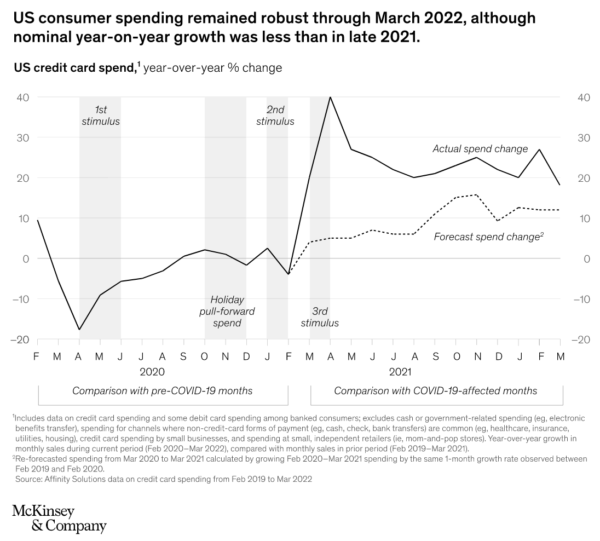
Inflation hasn’t stopped consumers from spending—yet. In the early months of 2022, amid record inflation, US consumers continued to open their wallets. US inflation grew to nearly 8.5 percent in March 2022, with the May 2021 to March 2022 period showing the highest inflation in a decade. Yet, US consumers spent 18 percent more in March 2022 than they did two years earlier, and 12 percent more than they were forecast to spend based on the pre-COVID-19 trajectory.
This loosening of purse strings was perhaps not surprising: US consumers had approximately $2.8 trillion more in savings than they had in 2019, and many didn’t hesitate to dip into those savings as pandemic restrictions eased across the country. But it isn’t just the savers who have been making purchases: credit card debt is starting to rise as well. People in every age cohort and income group spent more of their money, but year-over-year spending growth was highest among millennials (17 percent) and high-income consumers (16 percent). That said, consumer sentiment began to dip in late February, as we discuss further below.
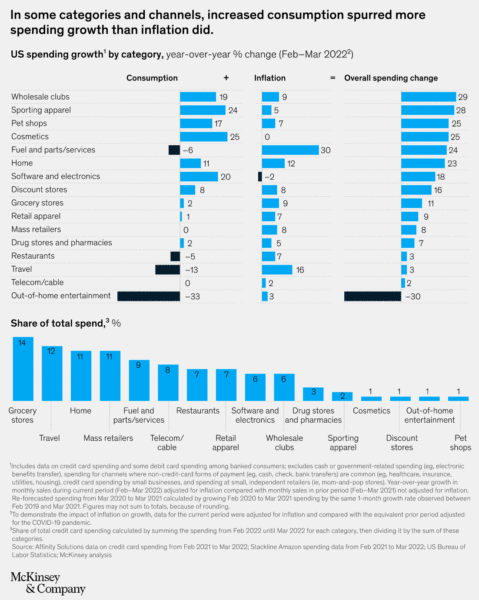
Consumers continue to spend more on certain product categories, but inflation is slowing volume growth. In some categories, much of the growth in spending in February and March 2022 was because people bought more; inflation accounted for only a small portion of growth. This was especially true in categories that boomed during the pandemic: sporting apparel, pet supplies, cosmetics, and software and electronics. But in other categories—including gasoline, restaurants, and travel—inflation has masked a drop in volume of consumption. Consumers bought mostly goods rather than services or experiences. Spending on goods was higher than prepandemic levels, whereas spending on services was still 2 percent lower than it was prepandemic—a pattern that will likely continue until more people feel comfortable being in crowds and attending public indoor events.
In light of persistent inflation and the war in Ukraine, consumer confidence—which rose steadily through 2021—dipped in February 2022. Only 38 percent of survey respondents said they feel optimistic, down from 44 percent in October 2021. The steepest drop in consumer sentiment was among high-income consumers, a group that frequently traded up to more-expensive products and brands in 2020 and 2021 but that might soon moderate what it buys. Companies will need to figure out the value equation that high-income consumers find most compelling: Will they continue to spend but start to trade down more than they did in 2020 and 2021? Will they shift more of their spending to channels providing better value?
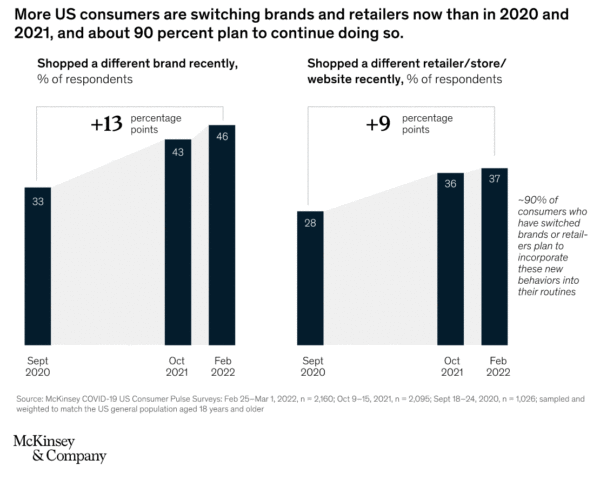
The “loyalty shake-up” continues. More US consumers reported switching to different brands and retailers in 2022 than at any time since the beginning of the pandemic—and most of them say they intend to incorporate that behavior into their routines. Their reasons? With inflation at a record high, more people are looking for value; price is at the top of the list of consumers’ motivations for switching. Almost all consumers—90 percent—have noticed that prices are going up. In particular, they’ve noticed significant price hikes in two things that many people buy multiple times a week: gasoline and groceries. Among consumers who said they’ve switched brands, slightly more than a third said they opted to buy private-label products.
Availability, which was a big reason for switching in 2020 and 2021, still matters a lot but is less of a differentiator than it was at the height of the pandemic, when some brands couldn’t keep up with demand and were constantly out of stock. Meanwhile, brand purpose is now less of a buying factor for consumers than it was in 2020. Novelty, on the other hand, has steadily risen in importance. Consumers are keen to try something different, making innovation an imperative for brands that want to win (or win back) consumers. Combining innovation with the perception of better value could be a particularly attractive offer.
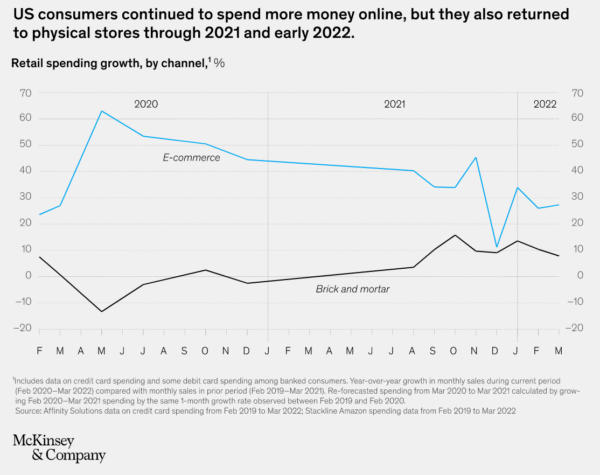
Shoppers are spending more both online and in stores. People began shopping online in droves at the start of the pandemic, when they didn’t have much of a choice. But it turns out that many people enjoy the convenience that e-commerce offers. Even when brick-and-mortar stores reopened, spending in online channels continued to climb. Year-on-year growth in e-commerce was 27 percent in March 2022; the total uplift in e-commerce penetration, from the onset of COVID-19 until March 2022, was 33 percent.
Contrary to what some in the industry predicted, the rise in e-commerce hasn’t made brick- and-mortar retail obsolete. In fact, in-store spending is recovering at a healthy clip—with 8 percent year-over-year growth in March 2022, compared with approximately 5 percent in early 2021. Providing a seamless experience in both online and offline channels is becoming table stakes for brands and retailers. In addition, companies would do well to differentiate the service and experience of in-person shopping, while giving consumers reasons to continue to visit their websites and apps.
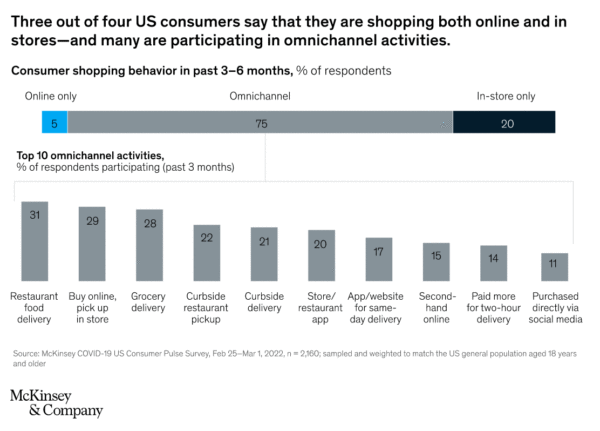
Omnichannel shopping is becoming the norm. Seventy-five percent of US consumers say they’re researching and purchasing both in-store and online. And this omnichannel behavior isn’t confined to a few types of products: consumers are doing it for both food and nonfood purchases across a broad range of categories. What’s more, 45 percent of consumers say social media is influencing their purchases.
Not surprisingly, social-media influence is heaviest among younger people and is most relevant in appearance-related categories such as cosmetics and sports apparel. Social commerce, already a phenomenon in China, is still nascent in the US market, but one in ten omnichannel shoppers said they’ve already made purchases directly via social media. It’s a channel that’s only growing in importance—yet too many consumer and retail executives today still haven’t taken the time to educate themselves in social media and thus are missing out on powerful opportunities to reach and engage consumers.
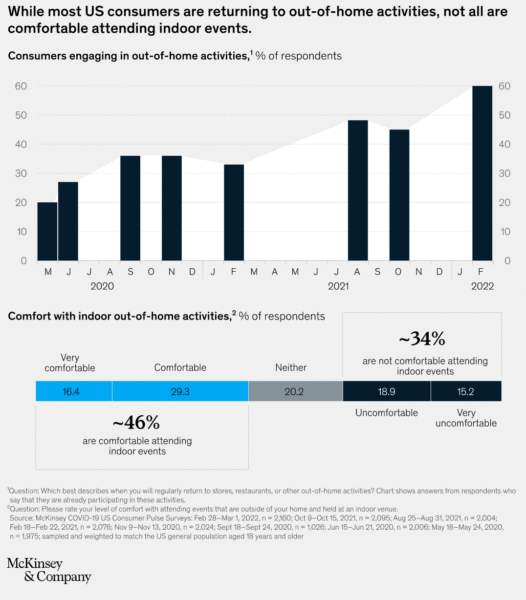
Even as people go out again, their “nesting” continues. More than half of US consumers have already resumed their normal out-of-home activities; another 20 percent are in the process of returning to their prepandemic routines outside the home. Almost 40 percent of survey respondents report that they’re now exclusively working in an office or other workplace outside the home. On average, consumers are working from home only about two days a week. But about one-third of consumers say they aren’t yet comfortable attending public indoor events.
Interestingly, despite resuming most of their out-of-home activities, US consumers haven’t pulled back on making their homes more attractive and comfortable. Spending on home improvement and maintenance is still growing: it’s 11 percent higher than pre-COVID-19 projections even after adjusting for inflation. Given the overall shift in the way people have used their homes during the pandemic as well as many people’s expectations of continuing to work from home at least one day a week, companies can expect this nesting behavior to continue.
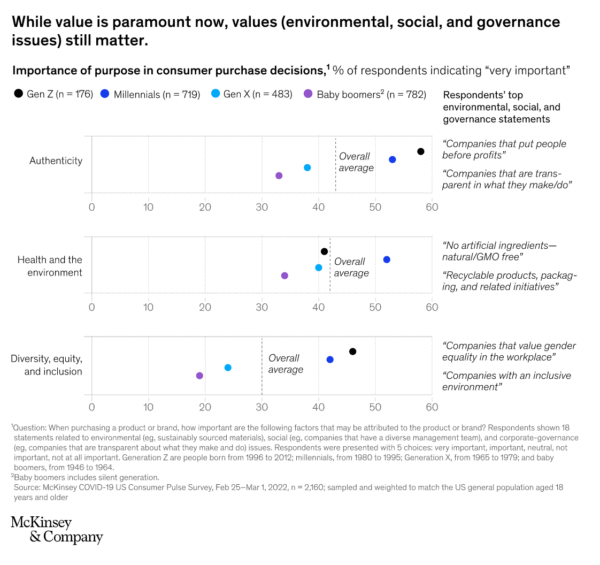
Consumers say they care about ESG, but it means different things to different people. When choosing which brands to buy, consumers—in particular, younger generations—say that their choices are at least somewhat influenced by environmental, social, and governance (ESG) factors. More than two-thirds of younger survey respondents said at least one aspect of ESG is very important to them. Paramount among their concerns is that companies are transparent and show that they care for people (employees, customers, others in their communities).
In general, younger consumers prioritize authenticity and social issues such as diversity, equity, and inclusion, whereas older consumers pay more attention to health and environmental issues. Today, with inflation driving many consumers to switch brands—value has become more of a motivator than values, so to speak—companies that can deliver on consumers’ expectations for both value and values will be best positioned for success.
While value is paramount now, values (environmental, social, and governance issues) still matter.
About the author(s)
Kari Alldredge is a partner in McKinsey’s Minneapolis office; Tamara Charm is a partner in the Boston office; Eric Falardeau is a partner in the Montreal office; and Kelsey Robinson is a senior partner in the Bay Area office.
The authors wish to thank Christopher Cannizzaro, Jordan Chmielarz, Aleksandr Gorushkin, Daniela Jamri, Andrea Leon, Daniela Sancho Mazzara, Jason Rico Saavedra, Meera Singh, and Tom Skiles for their contributions to this research.































